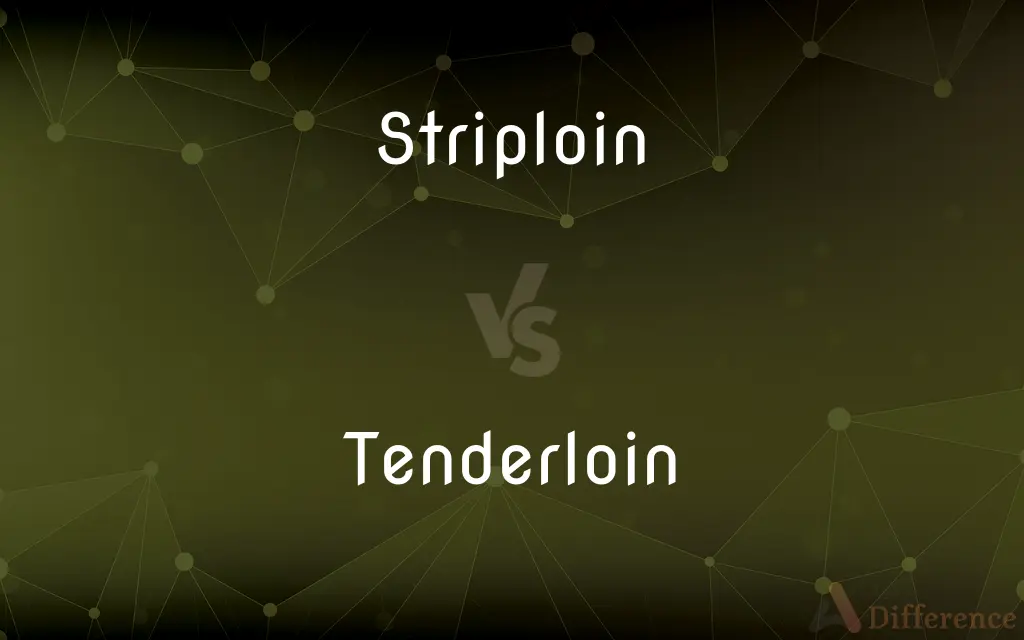Striploin vs. Tenderloin — What's the Difference?
Edited by Tayyaba Rehman — By Maham Liaqat — Updated on March 7, 2024
Striploin is a flavorful, slightly firmer cut of beef from the short loin, ideal for grilling or frying. Tenderloin, known for its tenderness and lean profile, comes from the loin and is preferred for delicate cooking methods.

Difference Between Striploin and Tenderloin
Table of Contents
ADVERTISEMENT
Key Differences
Striploin, sourced from the short loin section of a cow, offers a rich flavor profile due to its marbling. It is slightly tougher but remains juicy when cooked properly, making it a favorite for steaks and roasts. Tenderloin, on the other hand, is prized for its tenderness and lean meat, with minimal fat. It is highly versatile, serving as the source of filet mignon and Chateaubriand, and is often cooked using methods that preserve its moisture and texture.
While striploin steaks are known for their fat content that contributes to their juiciness and flavor, tenderloin steaks are much leaner. This difference in fat content not only influences their flavor but also their cooking methods; striploin can withstand higher heat, whereas tenderloin is better suited to quick searing or gentle roasting to prevent drying out.
Striploin cuts are generally more affordable than tenderloin, reflecting the balance between quality and cost. Tenderloin, due to its esteemed position as the most tender cut, often commands a higher price, making it a luxury choice for special occasions.
The texture of striploin offers a satisfying chew, which many steak aficionados appreciate for its balance between tenderness and firmness. Tenderloin, however, is almost buttery in texture, with less chew and a more delicate eating experience.
When selecting between striploin and tenderloin, considerations extend beyond just taste and texture; cooking skill and occasion also play critical roles. Striploin’s forgiving nature makes it a solid choice for a variety of cooking levels and methods, while tenderloin, with its need for careful cooking to avoid overcooking, might appeal to more experienced cooks or those seeking a special meal.
ADVERTISEMENT
Comparison Chart
Location on Cow
Short loin, near the back
Loin, along the spine
Flavor
Rich and beefy, due to marbling
Mild and subtle, with very little fat
Texture
Slightly firmer with a good chew
Very tender and almost buttery
Fat Content
Higher, contributing to juiciness and flavor
Very low, making it the leanest beef cut
Ideal Cooking Methods
Grilling, broiling, and pan-frying
Searing, roasting, or grilling with care
Price
Generally more affordable
Higher, considered a premium cut
Common Uses
Steaks, roasts
Filet mignon, Chateaubriand
Compare with Definitions
Striploin
Versatile in cooking methods, from grilling to broiling.
We broiled the striploin to perfection, achieving a crispy exterior.
Tenderloin
Features minimal fat and is highly lean.
He chose tenderloin for its lean profile, fitting his dietary preferences.
Striploin
A beef cut from the short loin that is flavorful and slightly tough.
The chef recommended a grilled striploin for a balance of flavor and texture.
Tenderloin
Often more expensive, reflecting its premium quality.
The tenderloin’s higher price is justified by its exceptional tenderness.
Striploin
Known for its fat marbling that enhances taste.
The striploin’s marbling made it exceptionally juicy.
Tenderloin
The most tender beef cut, located along the spine.
For a special dinner, she cooked a tenderloin roast that was incredibly soft.
Striploin
Suitable for steak lovers who appreciate a chew.
He prefers striploin steaks for their satisfying chew and robust flavor.
Tenderloin
Ideal for delicate cooking to preserve tenderness.
She seared the tenderloin quickly to keep it moist and tender.
Striploin
Offers a balance between cost and quality.
Striploin steaks provide great value for those seeking quality beef without the premium price.
Tenderloin
Used for luxurious dishes like filet mignon.
They served filet mignon from the tenderloin at the wedding, impressing all the guests.
Striploin
Beef tenderloin
Tenderloin
The tenderest part of a loin of beef, pork, or similar cut of meat.
Tenderloin
A city district notorious for vice and graft.
Tenderloin
The tenderest part of a loin of meat, especially of pork or beef.
Tenderloin
A district of a city where corruption is common, often because the district is devoted to questionable businesses (peep shows, etc) which are easy for police to blackmail and extort.
Tenderloin
A strip of tender flesh on either side of the vertebral column under the short ribs, in the hind quarter of beef and pork. It consists of the psoas muscles.
Tenderloin
In New York City, the region which is the center of the night life of fashionable amusement, including the majority of the theaters, etc., centering on Broadway. The term orig. designates the old twenty-ninth police precinct, in this region, which afforded the police great opportunities for profit through conniving at vice and lawbreaking, one captain being reported to have said on being transferred there that whereas he had been eating chuck steak he would now eat tenderlion. Hence, in some other cities, a district largely devoted to night amusement, or, sometimes, to vice.
Tenderloin
A city district known for its vice and high crime rate
Tenderloin
The tender meat of the loin muscle on each side of the vertebral column
Common Curiosities
Can I cook tenderloin and striploin the same way?
While both can be grilled or roasted, tenderloin requires more careful cooking to prevent drying out due to its lower fat content.
What is striploin best used for?
Striploin is best used for steaks and roasts, where its flavor and slight toughness are appreciated.
Which is healthier, striploin or tenderloin?
Tenderloin is leaner and thus could be considered healthier, especially for those monitoring fat intake.
How long should I cook striploin?
Cooking time varies by method, but it generally requires longer cooking times than tenderloin to break down the fat and tenderize the meat.
Is there a difference in the serving size of striploin vs. tenderloin?
Tenderloin servings may be smaller due to its richness and cost, whereas striploin portions can be more generous.
Is tenderloin or striploin better for grilling?
Both can be grilled, but striploin is more forgiving and better suited for traditional high-heat grilling.
How can I enhance the flavor of tenderloin?
Marinating or using a rub can enhance its flavor, along with careful searing to develop a crust.
Can I replace striploin with tenderloin in a recipe?
Yes, but adjustments in cooking time and method may be necessary due to differences in fat content and tenderness.
What are the nutritional benefits of tenderloin?
Tenderloin is high in protein and low in fat, making it a good choice for a lean diet.
Why is tenderloin more expensive than striploin?
Tenderloin is more expensive due to its unparalleled tenderness, lean meat, and status as a premium cut.
What makes striploin a popular choice for steaks?
Its balance of flavor, fat content, and texture makes striploin a popular choice among steak enthusiasts.
Why does striploin have a richer flavor than tenderloin?
The higher fat content in striploin contributes to its richer flavor compared to the leaner tenderloin.
What wine pairs well with striploin?
Full-bodied red wines, such as Cabernet Sauvignon or Malbec, pair well with the rich flavors of striploin.
How do I know when tenderloin is cooked perfectly?
Tenderloin is best cooked to medium-rare or medium, checked with a meat thermometer to ensure it doesn't overcook.
Is tenderloin good for roasting?
Yes, tenderloin is excellent for roasting, especially when cooked to medium-rare to preserve its tenderness.
Share Your Discovery

Previous Comparison
Context vs. Framework
Next Comparison
Annexure vs. AppendixAuthor Spotlight
Written by
Maham LiaqatEdited by
Tayyaba RehmanTayyaba Rehman is a distinguished writer, currently serving as a primary contributor to askdifference.com. As a researcher in semantics and etymology, Tayyaba's passion for the complexity of languages and their distinctions has found a perfect home on the platform. Tayyaba delves into the intricacies of language, distinguishing between commonly confused words and phrases, thereby providing clarity for readers worldwide.















































